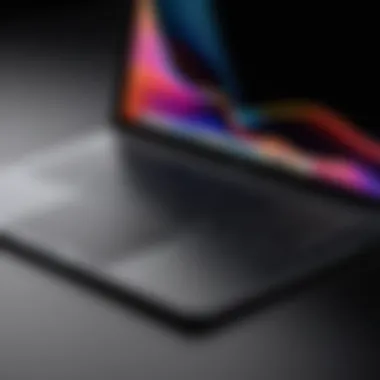The Black MacBook: A Comprehensive Analysis


Intro
The Black MacBook represents a notable chapter in Apple's history of portable computing. Released in 2006, its sleek design and robust performance drew attention from both casual users and professionals alike. To understand its impact, one must delve beyond its aesthetics and consider its specifications, capabilities, and place in Apple's product evolution.
Hardware Overview
Specifications
The Black MacBook is distinguished by certain technical specifications that define its capabilities. Primarily, it features a 13.3-inch display with a resolution of 1280 x 800 pixels. The model was powered by Intel processors, specifically Intel Core Duo, and later versions included the Intel Core 2 Duo. These components contributed to its ability to handle everyday tasks efficiently. Memory options ranged from 512MB to an impressive maximum of 4GB, which was substantial for its time.
In terms of storage, it offered a 60GB hard drive, with later iterations increasing to 120GB. Connecting peripherals was straightforward with multiple USB ports and a FireWire 400 port, enabling high-speed connectivity.
Performance Metrics
Performance testing of the Black MacBook reveals a device well-equipped for its target audience. Geekbench scores indicated satisfactory performance, particularly in web browsing and productivity tasks. Its ability to run applications like Microsoft Office and Adobe Creative Suite made it appealing for various users. However, it did struggle with more demanding activities, such as video editing or high-end gaming, which were becoming more prevalent at the time.
Battery life also played a critical role in the Black MacBook's appeal. Users often reported around six hours of moderate usage, which was competitive against similar models in the market. This endurance allowed professionals to work remotely without constant charging interruptions.
Software Analysis
Features and Functionality
The Black MacBook came pre-installed with Mac OS X Tiger, and later versions were updated to Leopard. This operating system offered a smooth user experience, facilitating multitasking and providing essential features like Exposé and Spotlight. The range of software available to users further enhanced the Black MacBook's capabilities, making it a versatile tool for both leisure and productivity.
Notably, Mac OS X's user-centric design simplified complex tasks, allowing users to focus on their work rather than the operating system.
User Interface and Experience
The design of the Black MacBook does not just apply to its external aesthetics. The user interface provided a clean and intuitive experience. The integration of the Multi-Touch trackpad enabled efficient navigation within applications. Users reported that the keyboard was comfortable for extended typing sessions, contributing to a more enjoyable overall experience.
In summary, the Black MacBook merges effective hardware and thoughtful software design. For IT professionals and tech enthusiasts, understanding these facets is crucial to appreciating its influence on Apple's later products.
"The Black MacBook not only marked a shift in design but also demonstrated Apple's commitment to creating a powerful portable computing platform."
As we continue this exploration, it is essential to reflect on how the Black MacBook influenced not just users at the time but also the evolving landscape of portable technology.
Preamble to the Black MacBook
The Black MacBook represents a pivotal moment in Apple's history. Launched in 2006, this model not only showcased Apple's commitment to design innovation but also highlighted its approach to brand differentiation in the portable computing market. Understanding the Black MacBook is essential for appreciating its influence on subsequent laptop designs.
Overview of the Black MacBook's Release
The Black MacBook was first introduced alongside its white counterpart during the early days when Apple was redefining consumer expectations for laptops. This model came equipped with distinct features that appealed to a more professional audience while retaining the user-friendly aspects Apple is known for. Apple released the Black MacBook as a part of its effort to broaden its market. The choice of black not only catered to aesthetic preferences but also set a tone of sophistication that many users found appealing.
Notably, the Black MacBook was often bundled with upgraded specifications, including better processors and increased memory options. This alignment allowed it to stand out in a competitive landscape where device performance and aesthetics were crucial in attracting consumers. The model’s initial reception was promising, with many tech enthusiasts and professionals praising both the visual appeal and functional capabilities.
Significance in Apple's Product Line
The introduction of the Black MacBook signified more than just a new color option. It marked a shift in Apple's branding strategy, targeting a demographic that appreciated both style and higher performance in computing devices. This model helped pave the way for the future lines of MacBooks, establishing benchmarks in design and performance that would be emulated in later releases.


This model also continued Apple's legacy of making high-quality laptops for creative professionals. The Black MacBook often symbolized a blend of innovation and elegance, reinforcing Apple's image as a leader in the tech industry. Not just a product, it became part of the culture within the tech community, influencing how consumers viewed the MacBook line overall.
Design Features
The design of the Black MacBook plays a crucial role in understanding its overall appeal and functionality. Design features encompass aesthetic considerations, material selection, and ergonomics and build quality. Each element contributes to the laptop’s identity and influences user experience. The design unites form and function, a pivotal aspect of Apple's philosophy. It reflects aesthetic delight while delivering reliable performance, making it essential to explore the Black MacBook's design.
Aesthetic Considerations
The Black MacBook stands out visually in Apple's lineup. Its sleek, black exterior exudes sophistication and elegance, distinguishing it from the more common silver and white color schemes. Apple aimed for a minimalist look, and the result is a device that appeals to both professionals and stylish consumers. The glossy finish enhances visual appeal but also showcases fingerprints and scratches, raising considerations about maintenance. It is important to note that the design is not purely superficial but a coherent blend of style and purpose, targeted toward users who value visual identity in technology. This aspect of the design elevates the Black MacBook as more than just a tool but an expression of personal taste.
Material Selection
Material selection directly influences the Black MacBook's durability and user experience. Apple utilized a polycarbonate shell, known for its lightweight yet resilient characteristics. This choice of material is significant for portability, an essential feature in laptops. Polycarbonate allowed Apple to create a unibody design, enhancing structural integrity. However, while polycarbonate is durable, it may not withstand extremes like metal. This brings to the fore a critical balance between weight and robustness in portable devices. The choice aligns with Apple's preference for materials that fuse aesthetics with functionality, contributing to the device's distinctiveness in the competitive landscape.
Ergonomics and Build Quality
The ergonomics of the Black MacBook are designed to enhance user comfort and efficiency. The keyboard design features a layout that promotes effortless typing, which is crucial for extended use. Additionally, the trackpad is spacious and responsive, facilitating smooth navigation. Build quality is a non-negotiable aspect of any device's design. The Black MacBook exhibits high standards in this regard, promising longevity. Users reported that the hinges remain solid over time, ensuring that the screen stays in place while being used. This attention to detail reinforces the idea that user experience is central to the design philosophy. Ergonomic considerations also include the balance of weight and dimensions, making the laptop suitable for frequent travelers.
"The design of the Black MacBook illustrates a commitment to aesthetic value paired with practical considerations, making it a pivotal element of Apple's innovation in personal computing."
Comprehensively, the design features of the Black MacBook encapsulate a careful orchestration of style, material durability, and ergonomics. These elements not only enhance the user's experience but also reflect Apple's intention to create devices that resonate with both form and function. This underlines the device's significance in the realm of portable computing and establishes the Black MacBook's legacy within Apple's product narrative.
Technical Specifications
In the realm of portable computing, technical specifications serve as a critical benchmark for evaluating performance and usability. The Black MacBook, known for its distinctive design and solid performance, offers a range of specifications that cater to both casual users and professionals. It is essential to understand its architecture to appreciate its place in Apple's product history and its influence on future devices.
Processor and Performance Metrics
The heart of any laptop is its processor. The Black MacBook was equipped with Intel's Core 2 Duo processor lineup. This choice was significant as it marked a shift towards more powerful and energy-efficient computing. The base model featured a 2.0 GHz processor, which offered ample power for everyday tasks such as web browsing, document editing, and multimedia consumption.
Considerations of performance metrics include clock speed, cache size, and thermal design power. The Black MacBook's processor supported a 4MB L2 cache, enhancing its ability to perform complex calculations more efficiently. Users noted that this combination allowed for seamless multitasking, an important feature for IT professionals who rely on handling multiple applications concurrently.
Memory and Storage Options
Memory and storage play a vital role in determining a computer's responsiveness and capability. The Black MacBook shipped with either 1GB or 2GB of RAM, with upgrade options available at the time. Although these specifications seem modest by today’s standards, they were adequate for the typical user during its release period.
Storage options varied, with the standard offering being a 60GB hard drive. For those needing more space, an option of 120GB was also made available. This range provided sufficient capacity for documents, software, and media, although modern standards have significantly increased storage needs. Users looking for performance enhancements often turned to SSDs for faster data access, although this was outside the default configurations.
Graphics and Display Quality
The Black MacBook featured an integrated Intel GMA 950 graphics processor, which while sufficient for general tasks, was not designed for intense gaming or graphic design work. The 13.3-inch glossy display supported a resolution of 1280 x 800 pixels, striking a balance between size and portability. Notably, the quality of the screen garnered mixed reviews. Casual users appreciated the vibrant colors and sharpness, while more demanding users described it as lacking in color accuracy for professional tasks, such as graphic design or photo editing.
"While the Black MacBook may not have set the standard for graphic fidelity, its performance in everyday applications was consistently reliable, making it a practical choice for many users."
Software Ecosystem
The software ecosystem of the Black MacBook is a critical aspect that defines its usability and relevance in the tech landscape. It encompasses the operating system compatibility, native applications, user experience, and interface design—all of which contribute to how users interact with the device.
Operating System Compatibility
One of the key factors for the Black MacBook’s appeal is its compatibility with various operating system versions. Originally, it shipped with Mac OS X 10.4 Tiger and later updated to versions like Leopard and Snow Leopard. This long list of compatibility allowed users to remain connected to a broad range of applications, ensuring extended usability. Older applications, specifically designed for pre-Intel architectures, still ran effectively in emulation modes.


Moreover, with the management of updates, Apple ensured that even users of older models had options to upgrade to newer systems without drastic hardware adjustments. Understanding the significance of this backward compatibility is essential for novice and seasoned users alike, promoting a simplified transition between operating systems while using the Black MacBook.
Native Applications and Utilities
The Black MacBook comes equipped with a suite of native applications which enhance productivity and creativity. Applications like iWork, iMovie, and GarageBand were pre-installed, providing users powerful tools right out of the box.
- iWork Suite: Includes Pages, Numbers, and Keynote, allowing for document creation, data organization, and presentations.
- iMovie: Offers straightforward video editing functions for casual filmmakers.
- GarageBand: Introduces music production to users with various virtual instruments and recording capabilities.
These applications fostered a user-friendly environment for those keen on multimedia tasks, reinforcing the notion that this device caters to both professional and amateur needs. The ability to integrate new third-party applications further widens the Black MacBook's utility, giving tech enthusiasts options to customize their setups according to individual preferences.
User Experience and Interface Design
User experience on the Black MacBook is meticulously crafted, marrying aesthetically pleasing design with intuitive functionality. The operating system promotes smooth navigation and ease of use, making it accessible to both newcomers and experienced users.
- Interface Layout: Elements like the Dock, Menu Bar, and System Preferences offer users organized access to tools, reducing learning curves.
- Trackpad Gestures: The introduction of multitouch gestures allows a more dynamic and interactive browsing experience.
- Display Quality: High-resolution screens ensure crisp visuals, enhancing engagement with UI elements.
The blend of these elements establishes an exceptional user experience, whether for casual browsing, professional tasks, or creative pursuits.
In summary, the software ecosystem of the Black MacBook is fundamental to understanding its place in computing history. Its compatibility, bundled applications, and thoughtful interface design all converge to provide users a comprehensive and effective computing environment.
User Reception and Critiques
Understanding user reception and critiques of the Black MacBook is essential to grasp its overall impact and legacy. This evaluation sheds light on how the device was perceived at launch, as well as how it has aged over time in the eyes of its users. Market response reflects not only the product's immediate success but also its place within the competitive landscape of technology. Long-term user feedback provides insights into durability, usability, and how well the Black MacBook meets the needs of its audience.
Market Response at Launch
When the Black MacBook was unveiled by Apple, it drew considerable attention. The sleek design and premium finish stood out distinctly from its predecessors. Initial reactions from reviewers and customers were generally positive. Many praised the device for its performance, especially for tasks such as graphic design and video editing. The combination of the Intel Core Duo processor and a high-resolution display made it appealing for professional and personal uses alike.
"The Black MacBook represents a turning point in Apple's laptop design, merging aesthetics with high performance."
Despite the overall enthusiasm, some critiques surfaced. A section of the user base expressed concerns about the glossy finish. Users noted that it was prone to fingerprints and scratches, which detracted from the device’s visual appeal over time. Additionally, pricing was also a point of discussion. While many were willing to pay a premium for the design and features, others felt it was exorbitant for a non-Pro model.
Long-term User Feedback
As time passed, long-term users provided a more nuanced perspective on the Black MacBook. Many users appreciated its reliability in daily tasks. Reports often highlight the longevity of the device, particularly in terms of battery life and performance. Users who engaged in heavy applications noted that while it handled tasks efficiently in the beginning, performance may lag after several years of consistent use.
Furthermore, critiques regarding the keyboard and trackpad emerged. While initially well-received, the feedback indicated some users experienced issues with the trackpad responsiveness over time. Many found that the keyboard accumulated dust and debris, which affected typing experience.
Another important aspect considered was Apple’s support for the Black MacBook regarding software updates. As newer models emerged, users grew concerned over the diminishing support for legacy systems. Users began feeling the limits of operating system compatibility as newer software required more resources than what the Black MacBook could provide.
In summary, while the Black MacBook was celebrated for its stylish design and solid performance at launch, long-term feedback has revealed certain weaknesses that prompted users to weigh the pros and cons of their choice. The friction between aesthetics and functionality remains a significant part of user discussion around this model.
Comparative Analysis
Understanding how the Black MacBook stands in relation to other models is crucial for a comprehensive examination of its place in Apple's lineage. A comparative analysis provides valuable context. It highlights not only the unique attributes of the Black MacBook but also the collective evolution of MacBooks. By juxtaposing this model with its contemporaries, readers can grasp the shifts in design philosophy, performance standards, and target audiences over time. It becomes evident that the influence of one model often drives innovation and change in others.
Black MacBook vs. White MacBook
Comparing the Black MacBook with the White MacBook reveals stark contrasts in both design and functionality. The Black MacBook emerged as a premium alternative to the more affordable White MacBook. Visually, the Black MacBook's sleek, dark casing suggested elegance and sophistication. In contrast, the White MacBook, with its bright plastic exterior, catered more to casual users or students.


In terms of specifications, the Black MacBook often boasted enhanced features. For example, it commonly offered a higher processor speed and better graphics capabilities. Users searching for professional-grade performance might lean toward the Black MacBook, while those in need of basic functionality often found satisfaction with the White variant.
Furthermore, pricing strategies highlighted the divide. At launch, the Black MacBook typically came with a premium price tag compared to the White MacBook. This created a perception of exclusivity and deeper functionality associated with the black variant. However, this divide also made the White MacBook more accessible to a broader audience.
"The Black MacBook not only differentiated itself visually, but it also appealed to a segment seeking more substantial power in their portable computers."
Black MacBook vs. MacBook Pro
When analyzing the Black MacBook against the MacBook Pro, the differences become even more pronounced. The MacBook Pro was designed explicitly for professionals, emphasizing high-end performance and advanced capabilities, while the Black MacBook targeted both enthusiasts and casual users.
The Black MacBook’s specifications were robust but did not reach the performance levels of the MacBook Pro. The Pro version offered superior graphical performance, faster processors, and more memory options conducive to handling demanding applications like video editing and software development. For professionals, this was a vital distinction.
However, the Black MacBook had its own advantages, notably its lighter weight and lower cost compared to a similar MacBook Pro configuration. This made the Black MacBook a compelling option for those who needed reliable performance without the additional features and price of the Pro model.
In summary, the Black MacBook represents a mid-point in the MacBook hierarchy. It offers a blend of style and functionality that appeals to a segment wishing for quality without the premium burden often associated with the MacBook Pro.
Legacy and Impact
The Black MacBook stands as an essential milestone in Apple's narrative, having influenced both design philosophy and technological direction within the company. Understanding its legacy is crucial for appreciating how Apple approached the portable computing sector thereafter. The Black MacBook did not simply serve as a laptop; it represented a convergence of form and function that defined a new era of consumer laptop design. This section will explore the significant elements of its influence, as well as the various benefits and considerations that stemmed from its introduction.
Influence on Future MacBook Designs
The design and features of the Black MacBook have resonated through subsequent models. The sleek, minimalist aesthetic became a hallmark of Apple's approach to product design. Its introduction of a black casing was not just a color choice; it implied a move toward branding that suggested sophistication and edge. Future models, like the MacBook Air and MacBook Pro, drew inspiration from the Black MacBook's blend of portability and elegance.
- The shift to aluminum casings in newer models maintained the sleek appearance initiated by the Black MacBook.
- The emphasis on lightweight materials and portability also persisted, further solidifying the demand for slim yet powerful laptops.
- Features like the ambient light sensor and improved keyboard layout appeared in even more advanced models, showcasing a commitment to iterative improvement based on user feedback gleaned from the Black MacBook era.
These factors illustrate how the Black MacBook laid the groundwork for Apple’s swift evolution in laptop design and usability, shaping its future product lines significantly.
Cultural and Technological Influence
Beyond its design, the Black MacBook also made a mark on both cultural and technological fronts. At launch, it appealed not only to tech enthusiasts but also to creative professionals looking for synergy between power and aesthetic. The Black MacBook became a staple amongst graphic designers and aspiring filmmakers.
- It catalyzed the culture of mobile computing, urging users to see laptops not just as tools but as personal statements.
- Its role in pop culture can be observed through various creative fields, where the device was featured in films and visual media, thereby enhancing its status as a trendy choice among young adults.
- The shift towards integrated systems within the Black MacBook propelled Apple's software ecosystem, encouraging a holistic user experience that other manufacturers would eventually emulate.
"The Black MacBook is more than just a computer; it is a representation of a shift in user expectations and design sophistication."
Through these discussions, it is evident that the Black MacBook's legacy remains influential, marking an important period in the continuum of tech innovation and consumer culture. The impact resonates today as we analyze its contributions to modern computing.
Finale
In summarizing the insights found in this article about the Black MacBook, it is essential to highlight its multifaceted significance in the landscape of portable computing. This model served not only as a bridge between Apple's consumer and pro offerings but also established a series of expectations for future designs and performance metrics. The Black MacBook is a symbol of the innovation and thoughtfulness that can arise from catering to both casual users and professionals.
Key elements discussed in this article included the Black MacBook's design features, technical specifications, and software ecosystem. Each of these facets plays a crucial role in understanding why this model became a notable contender in the market. The various features provided substantial benefits, particularly for users who demanded a balance between aesthetics and functionality. It embraced a certain minimalism while ensuring robust performance, showcasing Apple's attention to user needs.
Furthermore, the consideration of market reception, both at launch and in the long-term, gives a clearer perspective on how the Black MacBook evolved over time. The comparative analysis with other models notably illustrated its unique positioning and legacy, contributing to Apple's identity in the tech space.
Ultimately, the Black MacBook stands as a noteworthy example of how thoughtful design and powerful performance can intersect. Its impact on future MacBook designs and its cultural relevance offer ample opportunity for reflection in the tech world.
Benefits of Citing Sources
- Establishing Credibility: Citing authoritative sources bolsters the legitimacy of the article. It shows that the writer has conducted thorough research and is presenting factual information.
- Supporting Claims: When analyzing user reception or legacy impacts, having citations enables the author to substantiate claims effectively. This allows the audience to see the basis of the arguments made.
- Facilitating Further Research: Providing references can serve as a navigation tool for readers interested in exploring further into the topic. This can lead them to related articles, landmark studies, or other resources that deepen their understanding.
Considerations Around References
Writers must be cautious when choosing sources. Peer-reviewed journals or verified publications should be prioritized. Misinformation, or biases from less credible sources can mislead the audience. The accuracy and reliability of the information presented directly reflects on the quality of the article as a whole.
"Citations are not just a formality, but a prerequisite for conveying depth and reliability in an informative article."



